Jean Louis Lesch
Introduction.
In America, many classical riders never have been in contact with a real classical school. It is always a second-hand education, more or less distorted by the teacher's beliefs. I asked Jean Louis Lesch to write an essay about his evolution from the French classical school known as "Le Cadre Noir" of Saumur. We both have graduated from Saumur. We both wore the black uniform within the same period. Jean Louis was at Saumur; I was at Fontainebleau assisting Michel Cochenet, the French International Three Day Event Team coach. Since our classical education at Saumur, we have evolved in different directions. Jean Louis thinks that respecting the tradition of the cadre Noir that we both knew would better serve the equestrian sport and art. I have evolved toward a more scientific approach. I believe that upgrading the wisdom of our ancestors to an actual understanding of equine physiology and body function better serves equestrian art and sport.
Jean Louis wrote about his experience at the "Cadre Noir" with humility, factually and sympathetically. I love his direct and honest style. His essay is an excellent refreshment from the theologians who depict the Cadre Noir" as mystical and austere. Jean Louis presents an honest and factual view of his life at the Cadre Noir. I hope that posting Jean Louis' description of his life at Saumur will trigger intelligent questions about the principles of a school that we both dearly respect, and our evolutions. Jean Luc Cornille
Jean Louis Lesch
presentation

Jean-Louis Lesch joined the Cadre Noir in 1969 and left in 1972 1
Jean Louis Lesch, in a Courbette
© Alain Laurioux
I. Towards the world of horses
A. A. The beginnings

Jean-Louis Lesch
j.l.Lech
© personal collection
I was born in Algeria, in 1947. I returned to France in 1962. My parents were not in the equestrian world, and it was thanks to a neighbor, who was also a racing fanatic, that I caught the "virus". After my 6th grade exam, my parents finally enrolled me in the CHA (Club Hippique d 'Alger - the Algiers Equestrian Club). I was fortunate to be trained by Guy Cailleton, an extraordinary teacher. I think he had done an internship or a course in Saumur and had served in SHN (the National Equestrian Society). If I remember correctly, he produced several high-level riders. Back in France, on the French Riviera, I stopped riding for a year or two. Then my parents moved to Bergerac. At the riding stable in Bergerac, I met Philippe Blondel, a former member of the Cadre; Philippe Blondel was a contemporary of Jean-Jacques Guyon, Jacques Remiat, and others. In that period, we often participated in courses organized by the League with the Commander of Fombelle in Limoges. During this time, I regularly met Jean-Marie Donard, who later followed me.
I must tell you a little anecdote, the day that I was supposed to have the second part of my baccalaureate exam, I made a choice: my exam or my first international equestrian competition. I decided to go to the competition (without telling my parents). I won. I should have stopped there because it was a 100% victory in international competition, even if only Frenchmen were there. But I also won a disagreement with my father, and it was at that time I decided to commit to the Cadre to pursue my dreams.
II. Towards the life of a horseman
B. A. Becoming a horseman
1. Arriving at the Cadre Noir
In reality, things were not as simple as just following my passion. There was no problem integrating the cavalry to go to the Cadre, but I went through the drills and other military duties. Once this period was over, I took the tests for the student master class led by Philippe Blondel. The selection manager was Remiat, which certainly facilitated my acceptance. The training period went well, and I remained at the Cadre. I had a choice between Fontainebleau or Saumur. I preferred to stay at the Cadre Noir at Saumur.
So I was the youngest who had been dressed in black. Jean-Louis Guntz and I were the youngest to wear the black uniform at 19 and a half years old. We were born the same year, only a few months apart. I was at the Cadre Noir from 1969 to 1972
Jean Louis Gunz on the heights of Saumur

© Alain Laurioux
Jean Louis Guntz, civilian squire, 1993 (4)
2. The Cadre Noir at the time
At that time, the Cadre was purely military. It was composed of masters, deputy masters and ecuyers, (squire,) and deputy ecuyers. This hierarchy had little to do with the quality of the rider. The hierarchy was about their rank as military.
When entering the Cadre as a deputy master, one quickly passed the scale 4, which corresponded to a military examination to become chief or officer and, by equivalence, one became master of the stables.
Of the 12 masters and deputy masters there must have been seven or eight stable masters. Only one was the titular stable master, the oldest in the highest grade. He became the boss of the masters and deputy masters.
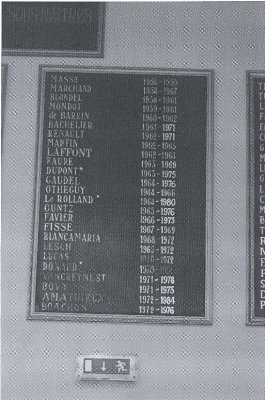
Table of the deputy masters hung in the lobby of the large stable.
Table of deputy masters
© Black Cadre archives
3. Training at the Cadre Noir
When I arrived at the school, there were no civilians in black. They started later to admit civilians to become deputy master during the course to prepare their instructor's diploma.
During the pre-training from October to Christmas, civilians and the military riders were together. After a selection, ten people participated in the training program. Then, after a few days of vacation, the actual training program began with those ten selected people.
Captain Henri Boyot was in charge of Maurice Bachelier during my training as deputy. Georges Fauré mainly managed the rider's form and discipline.
Boyot made us work on dressage. We did a lot of saddling with flexibilities and long sequences of trot without stirrups, led almost always by Bachelier.
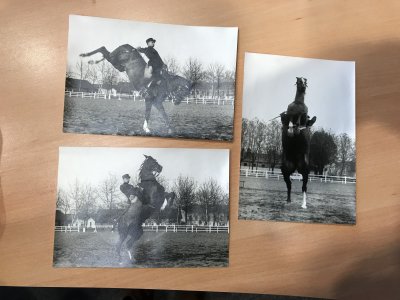
Officer Bachelier on Number One, Courbette, October 1968
131-1 BAC4 ?? to scan !
© Black Cadre archives
Above all, we worked on our "position," although a more sensible term would be our "coordination," trying to stay as balanced as possible over our center of gravity. We also had one theoretical session in the hall per week, but it was more theory about the horse, skeleton, muscles, and locomotion. Commandant of Faucompret, who was a veterinarian, gave the course. We also worked with leapers once a week. This meant going to the pillar with Mimosa, a famous horse, and serving as "models" to the deputy masters on their young jumpers as they made them work the airs above the ground on foot.
Apart from the internal competitions at the school, the training program often ended with the 3rd or 4th round of Saumur's eventing competitions. At the end of this training period, the civilians returned home, and the military riders went either to Fontainebleau, to the CSEM, to the SNH or remained in Saumur at the Cadre.
Pillar work with Mimosa /
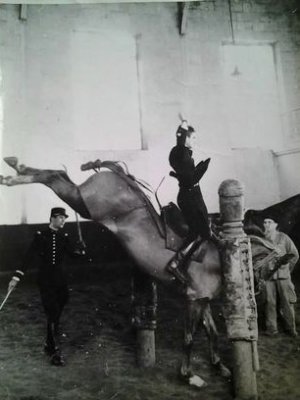
JLL at the Squire stables. Mimosa at the pillar JLL
© personal collection
II. Relations with other squires
There was a good atmosphere at that time, and I think the atmosphere is important, at least for me. Back in the day it was a military environment. The average age was 28 to 30 years, and at that age one is more likely to have fun and party, rather than at 50 years old or more. One had the impression of a well-established military hierarchy, but, at the end of the day, everyone spoke the same language. They were able to instill in us a solid foundation that then allowed us to evolve. Without these foundations, the means become a method that does not work.
Cochenet taught me a lot, he was our national coach. We were advised to go and see how the heads of series such as Guyon, Legoupil, etc., rode, and none of them had the same form.
The atmosphere among the deputy masters, from left to right: M. Bachelier, D. Biancamaria,
J. Gaudel, J-L. Lesch, P. Le Rolland, L. Favier.
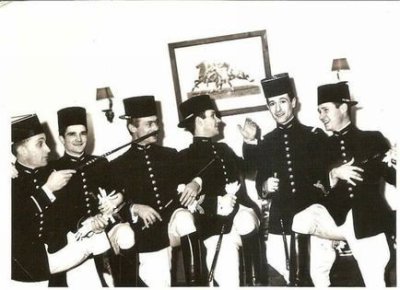
Atmosphere
© personal collection
C. Being a squire
1. Definition of the squire
The saying goes: "the habit does not make the monk," but I think it still contributes a lot. When we were in the "downstairs" buildings, and before the work clothes became what they are now, we were always in tunics. Everyone was fully dressed from morning to night, boots always waxed, ready to ride. The groom would put you on horseback and wipe the boots with a cloth to remove the dust. All the riders had almost the same template, which gave a visual uniformity to the whole.
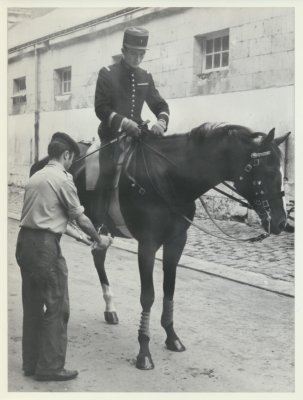
Colonel de Beauregard at the mount.
Montoir001
© personal collection
For my part, I think that a squire's main quality is to pass everything he thinks he knows on to his pupils and horses. Hoping that one day the pupil will surpass the teacher. The evolution must be in this direction.
Regarding the student/rider, never try to "put the cart before the oxen," that is to say, do not start by trying to put the student in a so-called "academic" position. Instead, I recommend putting him in a flexible and balanced over his center of gravity, the only element that will make it possible to use his assets and, therefore, his body weight. It was said of our time: natural aids are the legs, the hands of course, and the body's weight, which must remain the most important asset.
Regarding the horse's training, for which I prefer the term "horse education", we must never forget that the horse is prey and that its defense is flight. So we must never close the doors on it and keep it stuck between the hands and legs, but always leave a means of escape. When we create a symbiosis between the escape and the movement, then that is the Holy Grail. By respecting this concept, the horse will be well mentally and in harmony with the rider.
The concept is difficult to put into practice, but philosophically, it is the primary goal that the rider must seek. It is imperative not to go too fast, to go through a series of movements, the main objective is to manage to control the "frame," that is to say, a horse having an attitude that corresponds to its amplitude and its balance.
2. The typical day of a squire
We had mandatory hours in the morning at 7:30 and at 4:00 /4:30 to work with young riding horses or older jumpers in the evening. At those times, we were obliged to work together to help each other if necessary. At 8:30 am, we made an appointment at the Carrousel bar for a coffee. I can now confess that I often started my day there. It was a place where we often met retired elders of the "house" who maintained a habit of coming to give us precious advice. I think I learned a lot from these exchanges. These moments were mythical.
We worked the horses at the Manege des ecuyers (squires' indoor ring.) The Place gave the impression of entering a "temple" whose walls had knowledge far superior to ours.
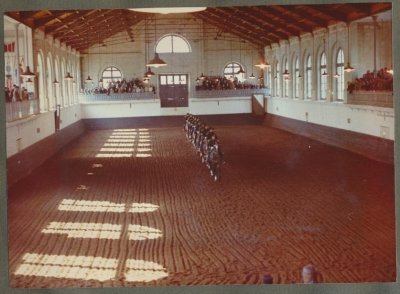
Resumption of the first Friday of the month in the former squires' indoor, 1st Friday of the month 1970
© Black Cadre archives
On our own, the rest of the day, we worked our sport horses or with other riders' advice. Once a week, in principle, we all had to go to Verrie to practice on slightly bigger cross-country obstacles. Another part of the training took place at the Breil racetrack. This diversity was very enriching.
The trottings and the horses' conditioning were done either galloping on the Breil racetrack or sometimes in Verrie. Sometimes trotting took place in the city. My favorite outing was to the castle, where the civilians and tourists who visited Saumur had the opportunity to see us. It gave the city the essence of being a "horse town."
Sometimes, but very rarely, we supervised training courses organized for civilians, even if the squires mainly gave them.
We worked our competition horses alone or almost alone. If we needed advice, everyone was willing to help us, and if we made mistakes, there was always someone to point them out and help us rectify them. Before each eventing or dressage competition, it was mandatory to present the ride to the chief squire, Colonel de Saint André. He was the one who would judge whether we could take part in the competition. He was like our "justice of the peace." In this way, he could check the work. He aimed to make us acquire "sensations" before giving us explanations to understand that these sensations are not accessible with a horse that does not work in the right direction. In retrospect, I think he was right. We must make sure that the rider discovers the sensations by himself and then theorizes them.
In summary, we often worked alone but were always surrounded by people who could help us. The atmosphere was very good. We lived like "billionaires with empty pockets".
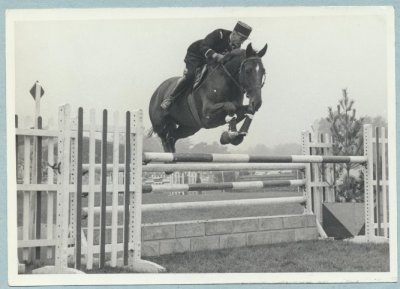
Guyon at a competition in Fontainebleau in 1966
Guyon, Fontainebleau 1966
© Black Cadre archives
Video ?? extract (CN 1984) race at Verrie 11'-11'19 to be checked
3. Galas and shows
In my day, there were few galas and shows. We presented the choreographies every Friday morning and once a month in Gala attire with white riding paint and white gloves. We also made a few small presentations in the vicinity of Saumur during horse racing competitions. However, we had the opportunity to participate in the Gala de l'Union des Artistes and a wonderful presentation in Place Vendôme to the music of the Republican Guard. In all modesty, I think that this is what gave the impetus to the current evolution of the shows
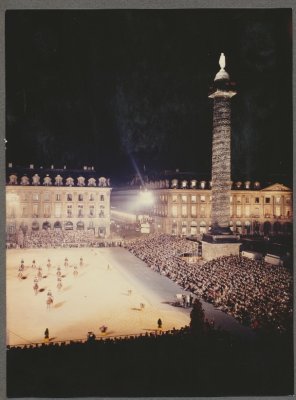
The ride to music in Place Vendôme in June 1970/71
Ride, place Vendôme, 1970-71 (2)
© Black Cadre archives
4. Competition
We rarely went to international competitions. The schedule and competitions were not the same as today. We mainly rode in France, whether in dressage or three day event like the 5th and 6th series at Haras du Pin, Fontainebleau, Pépin, Dourdan, etc.
Our specialty came from the horse, not the rider. Once a horse was assigned to us, we worked on it, and as it evolved, it was directed towards its preferred discipline. Or the discipline that suited it best was often dressage, eventing (or leaper, if nothing else worked). The leapers at that time were often the rejects and the un-trainable horses.
The masters and deputy masters presented the leapers. The squires presented the other routine known as "La reprise des ecuyers,"

Entry of the squires during a ride
Squires' ride
© personal collection
We were supposed to ride in all disciplines, I even rode once in a steeple chase race thanks to Michel Lucas as someone was missing to follow him at the Haras du Pin (I followed him until the finish line because he was first and I was second).
During my years at the Cadre Noir, I had to do four or five internationals. It was not my primary vocation, but on the other hand, we toured a lot in France, which was always exceedingly complicated in terms of logistics. The vans were military trucks, and sometimes the horses went by train, which was not simple!
When I left the Cadre, I actively participated with Guyon to establish and open the first equestrian village of the Club Méditerranée in Pompadour. During those years at the Club, I tried to teach the classic horseback riding that I had learned but adapted the style to make it a little more leisurely. It had to be a little more accessible to the general public, but I wanted to maintain the philosophy. In parallel with the teachers, I started to set up a three-day event team, which was beginning to participate in good level tests in all three disciplines. Among these teachers was François Salvy, who later served at the Cadre.
I left the Club Méditerranée to take over the Clermont-Ferrand riding club. I continued to do some eventing, but I realized that I was leaning slightly on "the handbrake" because I was somewhat wary of the cross country. I preferred to stop, and I cycled between dressage and show jumping depending on the possibility of renewing my trial horses. Subsequently, I dedicated myself to showjumping until the 2010s.
5. Competition and tradition
Here is the central question: competition and tradition. If tradition is understood to mean Baucherism, the followers of Baucher, we need to consider two points. Baucher has allowed riders to evolve enormously by looking for horses' "ease" through a sophisticated riding style. It forces riders to be above their center of gravity, more balanced and more refined in their movements. The quality of the gaits and fitness of the horse is not on the agenda. It is riding for show.

Currently, and for several years, the genetics of horses have evolved considerably. The bases for dressage and contact with the horse must remain the same. Always direct and organize your work to maintain your animal's natural looks and abilities. The main objective is to conserve natural gaits and balance constantly. You must gradually work on the flexibility, the physical condition, and the strength of the horse so that it remains obedient to you. Whatever the practiced discipline. It is essential not to go too fast and ask the horse only what it's ready to give. Maintaining the right mindset is necessary for greater efforts in more critical moments.
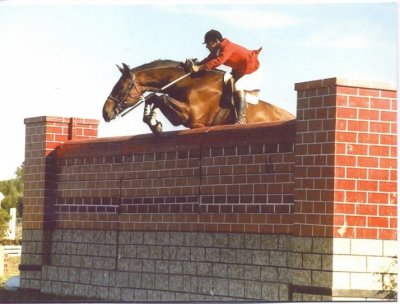
12 Jean Louis Lesch, Ourson du Parc
Jean-Louis Lesch in CSO on Ourson du Parc.
© Black Cadre archives
6. Highlights of his career
I could tell you a lot of funny anecdotes, but in the end, they are quite commonplace because they happen to everyone. I think the thing that had the most impact on me was when
The school had to move to Terrefort. The first time I went to the new facilities accompanied by Jean-Louis Guntz, after passing by the old stables and squires' indoor, I was a little starstruck when I entered this magnificent grand indoor ring. I had a strange feeling; that this indoor ring was empty! It knew nothing! When we entered the squires' indoor ring, we felt that the roof was going to "fall on your head" and above all that the walls knew and that they were "watching" you, like entering a monastery, a cathedral. They say the walls have ears; why shouldn't they know? They had received 100 years of knowledge.
I believe that this is one of the most emotional things that has impacted me throughout my entire equestrian career and even in my life.
D. To practice and pass on
1. Work and the relationship with horses
Each horse has physical abilities, relatively easy to see, and mental ones that must be considered and which are much less easy to discern. There are different disciplines and abilities; a horse may have good obstacle abilities but not like it, so you will never be able to take advantage of its abilities even if they are phenomenal. To remain in the theme of the Cadre Noir and talk about the leapers, every horse can move at a medium level, but if we speak specifically of caprioles, the horse must take "pleasure" in doing them to attain a high level. This discovery is a personal sensation.

May 1st during a capriole requested by Jean Louis Lesch
May 1st Capriole Bossut Stables
© personal collection
You have to "feel" the horses and find out what they like doing. This is the basis of the etiology. When you ride them, it is important to create a relationship. The elders with whom we drank coffee at the Carrousel bar spoke to us in etiological terms but without using these words. At work, the horse must be with you and you with it. Without going on too long on the subject, I think that if your horse is in a good mindset, has no muscle pain, and that you ask it what it can do over short periods, with sufficient rest to let him assimilate, then it will give you, little by little, its full potential.
Horseback riding is a bit like a couple's relationship. Each must be respectful towards the other, always allowing the "secret garden".
video ?? extract - during horse relationship-building 24'30-25
2. His most important horses
I had the chance to participate in a lot of competitions and have had the joy of being able to ride some very good horses at a high level in all three disciplines. At the Cadre Noir, as a military, my first horse was Jean-Louis Guntz's former horse, that he had ridden in the 4th series, Rakam. With him, I started the 4th series during my first year, some 5th series, and the French Championship of Coëtquidan. The horse was in an excellent state, and I think I had the chance to enjoy Guntz's arduous work.

Jean-Louis Lesch and Rakam at a competition in 1969 15
Jean Louis Lesch and Rakam, 1969
© Black Cadre archives
I started Nicomède in the 3rd, 4th, and 5th series and finished, before leaving the Cadre, with a 3rd place at the Olympic qualifiers. He was a very brave little Anglo, a winner. Nicomède made Alain Vancraeynest's days more beautiful after I left.

JLL and Nicomède during a 3rd series
Nicomède 1st 3rd series
© personal collection
As for leapers, we always had two horses, one young and one old. Here again, I had the chance to switch very often with Captain De Croutte, my boss at the time, and have fantastic horses like 1er mai and Olympique, who was also a real "caprioleur".
I was also able to go out in Saint-Georges dressage and intermediate with horses who already had experience in the discipline. The chief squire of the time, Colonel de Saint-André, pushed the young in all disciplines

Capriole of the horse, Olympique, during a performance
Olympique Cabriole JLL
© personal collection
When I left the Cadre as a civilian, I continued to practice, but I had to
"make" horses, and when I arrived at the big events, I didn't have enough guts to continue with the cross country, so I reoriented myself by following the horses in showjumping and dressage.
In showjumping, I had some outstanding horses like As D, my first "real horse," which allowed to enter the 1st category within just a year thanks to his gains. Darling, she was raced internationally and finished 6th at the French Championships. Ourson du Parc, on the other hand, is surely the best performer; he was always in the top five of the great prizes, and he won almost all the time.
I could list many horses like King of the Abbeys, a very competitive horse in the speed event, nicknamed "the Atlantic TGV" (it was small, grey and its nose was streamlined like the TGV) but the list would be too long. That's all I've done for almost 30 years; contemporaneously coaching riders in all three disciplines.

1er mai in a bow in the Bossut corral
1May bow Bossut
© personal collection
3. The squire as a transmitter
In this current generation, I find that we are those that transmit tradition the most. The base has remained exactly the same, but what we communicate is horseback riding, the real riding close to the fundamentals. Because we followed the evolution, but we always brought it back to our fundamentals.
III. The equestrian tradition
A. Retrospective
1. What riding / the horse teaches you about yourself
Some people have the skills and sensitivity to rise to a high level. The horse "is the mirror" for the rider's emotions and its moderator. But let us not forget that it is the rider who is the trainer of the horse, it is he who reads the regulations and the manual, he who trains it considering all that has been previously say. But if we look at things the other way around, I believe that horseback riding can change riders. But in this case, it would probably be called adult horse therapy.
When a person uses the horse as a psychological means to change one's mindset, the horse becomes a therapeutic tool. It is then more difficult to talk about one's well-being. I'm not sure the horse has the ambition of becoming a psychologist. The horse is always the mirror of your emotions, so if you are well, the horse is well, I doubt a little about the other way around. This may be less true for older horses that can "endure" as grandparents do with their grandchildren.
In horseback riding you learn this every day and all your life. I would even say that three lives would not be enough to grasp the issue fully. I think staying at the Cadre Noir for three or four years allowed me to learn a lot in Saumur with the veterans and on the competition grounds.
After the Cadre, we continued to work more or less together despite the geographical distances. Sometimes are in touch by phone or put the horses in the truck to go see the Cadre Noir veterans or the civilians. I am particularly thinking of Jacky Gaudel, Patrick Le Rolland and others of course. Finally, we continue to operate in the same way but without the uniform.
Riding well is like a three-sided pyramid. One side represents what you can do, the other is what you know, and the third is the mind and the will to do it. However, we must always keep in mind that these three things must progress and evolve simultaneously. If knowledge overwhelms skill, or if you do not have the mindset, the pyramid is unbalanced, and you will never progress properly.
Be careful not to become a "living room squire"! An intellectual of horseback riding but whose practice remains haphazard.

Rakam and Jean-Lesch in symbiosis at the French championship
Rakam Coëtquidan Champ France JLL
© personal collection
2. Those who influenced him in his career
I have met a lot of amazing people. The first was Guy Cailleton in Algeria. He had the gift of putting people in balance, forward movement, and confidence. I then met Philippe Blondel in Bergerac, who was leaving the Cadre. I learned the classical fundamentals with him-the commander of Fombelle, who was a real leader of men.
Then I worked with de Croutte, who was still captain at the Cadre noir at the time. I'm mainly talking about him when he was at the Cadre Noir, because he had a little bit of a temper, and I felt that he was misunderstood. Perhaps he was ahead of his time in terms of locomotion, ethology, and the horse's well-being. All these notions had not yet entered the morals or the program. Some people approached them instinctively but without any direction. All the veterans were spread all over France. The Internet and e-mails did not exist, and people communicated by mail. I am thinking especially of de Fombelle, de Saint-André and all the other great Baucherists.

De Croutte at the time "commander"
Commander De Croutte
© personal collection
B. The Black Cadre and the Equestrian Tradition
1. The UNESCO Definition of French Horseback Riding
I think it's a good thing. It was Loïc de la Porte du Theil who worked very hard in this area. At the time, there was talk of abolishing the Cadre Noir and military equestrian sports.
At its base, the Cadre must have the mission of transmitting "French" horseback riding, but I think that people do not go "in the field" enough and in clubs. I'm not thinking about squires, I'm thinking more about leaders. By broadening the debate, a little at the outset, the Black Cadre trained military instructors. This function then passed to the Federation for the training of instructors who, in my opinion, became club "camp counselors." Let me explain; it seems that the commercial side has taken precedence over the search for quality riding. As a result, perhaps some riders are turning to ethology.
I think that the role of the Cadre Noir should be that of transmission. I think many of us, many veterans, are still looking for this transmission. Transmission does not mean staying with medieval horseback riding. We must accept evolution, but our role would be that of a "retarder" so as not just let just anything happen.
Currently, everyone is looking to go very fast, while in horseback riding, "going slow is going fast" and the results arrive. In equitation, one can only achieve good results with good physical and mental self-control, and this is achieved by doing hours of saddle time and not by seeking to intellectualize.

Jean-Louis Lesch preparing his student before the cross-country event
Jll cross preparation
© personal collection
2. The role of a passer of the French equestrian tradition
First of all, what needs to be defined is the word "passer." One cans interpret passer in two ways.
The first, means bringing horses to a certain level which is relatively easy. It's the pairing of a good rider with a good horse. Suppose we start with a normal rider, with a good mindset, without prejudice, with a good horse especially, both with a certain talent, it is the Holy Grail. Unfortunately, this is what is written in the books, but we only encounter two or three throughout our careers.
About 20 years ago, student riders started with relatively well-trained horses. The main job was to have a good basis and the correct sensations to acquire a healthy foundation.
Currently, I would say that 75% of riders come to the Club with their horse but especially with "ideas" that are not necessarily the right ones. Horses are not mentally healthy and have dysfunctional gaits. Riders think they train their horses (herbivores) like their dogs (carnivores). The approach cannot be the same. My role as a "passer" is to retrain the horses and riders properly. Usually, at least a year is needed before starting working properly. Most of the work is in psychology for the rider and kinesiology for the horses. During this time, I have the impression that I am a psychologist putting "a convict" to work.
I think that the authorities have allowed horseback riding to deviate too much, giving too much space to leisure, social networks, and "charlatans." The "bad equestrians" do the rest.
I believe that the role of the passer is not to try and put the riders in a single mindset but to make them understand what equestrian sport is with respect to the health and well-being of the animal.
This is an important thing that IFCE should consider in trying to find ways to solve this evolution and change the direction of this dynamic.
C. Evolution of the Black Cadre and Horseback Riding
1. The evolution of horseback riding
Here, too, we must divide things. A good evolution goes in the right direction with good well-worked, well-treated horses with riders and owners that listen to them.
But beware, if we continue to let conspiracists and reactionaries preach anything and everything under the pretext of abuse, in 50 years, there will be no more equestrian sports. If jumping big obstacles with horses who have the ability to do so, or even to "walk" 30 cm above the jumps is considered mistreatment, then competitions will be abolished, and so will breeding, and so on. The tractors have replaced the draught horses, and, coincidentally, we are trying to get them back to work to maintain the breed.
I think we are at a decisive "turning point" about the future, especially regarding the balance between the practice of classical riding and the possible 'detractors' who use social networks and other means of communication. The balance should not tilt in the wrong direction. As a reminder, it is easier, especially in horseback riding, to talk rather than do! I think that some "great" veterans, still in the professional circuit, must continue to transmit the message both in France and abroad. All these former riders have received the same training and education they practiced in all disciplines. I am thinking of Donard and Jean-Luc Cornille, who has transmitted a great deal to the United States "in the footsteps" of Pierre Pradier, a great defender of locomotion. J.L Cornille explains the "sensations" more scientifically.
We learned very good foundations in Saumur on which we were able to build. The IFCE should draw on the work of the veterans with whom it must stay in touch in order to evolve together. The idea is to "hunt in packs and not advance alone" so that the "bad word" does not spread anarchically by "equestrian ad men" who rage on social networks among others.

Jean-Louis Lesch and As D at an obstacle contest
As D
© personal collection
2. The future of the equestrian tradition
I find that the tradition as I understand it lost a lot when the Cadre moved to Terrefort. I think we should have maintained the tradition with the rides and the horses in the old squires indoor once a week and once a month in the large outdoor ring of the Chardonnet during big presentations. I found it more traditional for people who visited Saumur to see riders in black passing in front of the cavalry school or working on the Place du Chardonnet at any time of the day. The Cadre Noir has always been linked to Saumur and, seeing horses in the streets, at the castle entrance, or in the city, gave the city an additional character and contributed to the respect of the Cadre's tradition.
Following this logic, Terrefort would have been a place of work. Everyone could have been in the current outfit, but the squires' ride and the old facilities would have remained a tradition. The riders who work in uniform would have allowed the Cadre Noir to remain something sacred is out of reach, in everyone's eyes.
3. Change to Black Cadre
In my time, there was a first part of the show, and then the presentation of Cadre Noir, The squires' presentation, and the leapers. The spectators eagerly awaited the presentations of the Cadre Noir. We can say that the first part was warming up the room.
At first, there were the rides of the squires which then had to develop. Then came the presentations of the leapers in hand. But I think one of the mistakes was to make "scenes", which meant competing with the entertainment professionals. If you consider a pure show like Lorenzo's or Alizé Froment's, they are truly spectacular. We must, therefore, not mix the professions. The Cadre Noir should remain in the endurance of French riding and competition in all disciplines to give an evolving image. It is certain that when Gildas Flament made caprioles with his jumper at two meters from the ground, it was an extraordinary spectacle.

Gildas Flament at the capriole
Alain-Laurioux---Black Cadre-IFCE--8-
© Alain Laurioux
Picket jumping, for example, can be part of a show but must be presented as part of a gathering of connoisseurs. I address this topic because I had the opportunity to live the experience. I live in Belgium, and there were echoes of this during a picket jumping presentation as part of a 5-star international equestrian competition in Bercy. The spectators had just seen riders jumping 1.60m obstacles and did not understand the picket jumping presentation. It is a pity to let difficult work requiring long hours of training fall into disrepute.
Jean Louis Lesch
"The goal of learning is not to shield old views against new facts. It is to revise old views to incorporate new facts." (Adam Grant)


